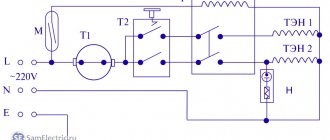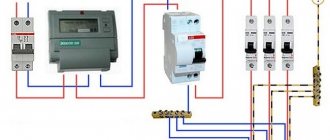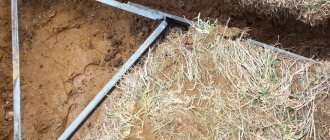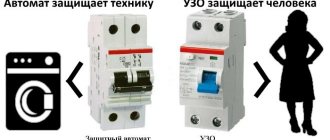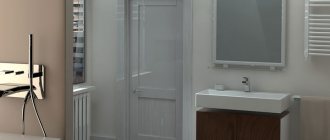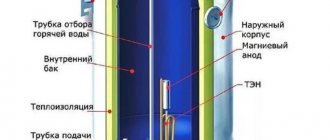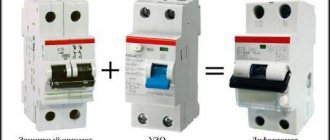How to choose a differential machine for a boiler
IN
Are you again sitting without hot water, because your utility company is once again repairing heating mains, or has been carrying out “prevention” for the second month to prepare the pipes for the heating season? A boiler is a way out of the situation for many, especially for summer residents. The range of boilers is huge - you can choose by design, color, and price. But remember that the correct connection plays no less a role than the purchase of the heating equipment itself.
We were explained how to connect correctly in the online store, which has been working in the field of electrical goods for more than 12 years - AxiomPlus.
.
1.
Be sure (!) to install a difavtomat for the boiler.
2.
Connecting the boiler by “branch” or “via a separate line”.
3.
How to choose protection for a boiler - or correctly say “from the boiler”.
4.
Correctly selected rated current is the key to reliable operation.
5.
And the last thing worth paying attention to is the manufacturers.
-article version
Connecting the boiler via a differential machine
Be sure (!) to install a difavtomat for the boiler
There are a number of reasons for this:
- The steel tank of the body is an excellent conductor of current;
- Water is also a conductor;
- Magnesium anode (a metal pin with a 10-15 mm layer of magnesium alloy applied to it) - protects the inside of the boiler from corrosion, but improves current conductivity;
- Accumulation of static electricity;
- Over a long period of use, corrosion may occur, which often causes differential current leakage.
Therefore, install the boiler out of the reach of children - there is no need to touch the body again or enter settings. Make sure to properly ground and install a differential circuit breaker, which will protect against electric shock, prevent fire and protect equipment from short circuits.
Connecting the boiler “branch” or “via a separate line”
It is recommended to lay a separate line for the boiler and connect it only to a grounded socket (follow the links to find out → how to install a socket and → make grounding in a private house and → make grounding in an apartment building). For such installation, you will have to spend money on a cable and a separate circuit breaker (follow the link to find out → how to do wiring in the house).
But if you connect the water heater like a regular electrical appliance, then if it goes into emergency mode, the entire apartment will be de-energized.
Be prepared to sit in the dark until you find the cause of the accident.
But you are installing a water heater in order to minimize inconvenience and provide comfort to all household members, and not create additional problems? Therefore, a separate line for it is the right solution. If the boiler does not have a built-in RCD, then even less so.
I recommend: How to make a plastic water pipe in the bathroom with your own hands
How to choose protection for a boiler - or, more correctly, “from the boiler”
A differential circuit breaker is two devices in one: an RCD and a circuit breaker, and each has its own characteristics. In an RCD, the main thing is to correctly select the leakage current. Make sure that the devices are located according to the principle of selectivity - the characteristics are increasing on the side of the boiler machine. Then, in the event of an accident, the RCD that is closer to the leakage site will be triggered, and not the input one, and will turn off only one line, and will not de-energize the entire house. For a boiler, it is enough to select a differential protection device with ΔI 30mA.
The response speed is a characteristic of tripping, there are three types:
- B - from 3 to 5×In - instantaneous operation, suitable for household appliances without inrush currents.
- C - from 5 to 10×In - has a slight response delay. For equipment with inrush currents.
- D - from 10 to 20×In - long delay, intended for powerful industrial equipment.
For boilers, choose the characteristic of release B - this is quite enough. It is preferable to choose the type of mechanism electromechanical (the differential machine continues to function even if the neutral wire is broken) with type A (sensitive to sinusoidal alternating and direct current) or AC (alternating current).
Correctly selected rated current is the key to reliable operation
There is a myth that you need to choose circuit breakers and automatic circuit breakers with a large reserve of rated current - they say it’s more reliable, there will be no overload and false alarms. And they often buy 32 A or 40 A circuit breakers for low-power devices.
Look at the power of your boiler and choose a difavtomat with a higher rating. But make sure that the margin does not exceed 20%. This is important, because with a large excess in rated current, the protection will operate more slowly (the thermal release takes a long time to heat up). In case of a short circuit, where the current level exceeds the permissible level tens of times, a long operation can have disastrous consequences.
Boilers are not particularly powerful. The maximum current strength of household appliances (which we encountered) is 12 A. Therefore, a differential circuit breaker with a rated current of 20 A (well, a maximum of 25 A) will be sufficient for any household boiler. But look at your heating equipment - remember the allowable margin.
Selecting a protection device
Based on the above characteristics, an RCD is selected, but do not forget to take into account the condition of the bathroom (high humidity).
Give preference to type “A” devices that respond to alternating and direct current. Despite the fact that sinusoidal alternating current flows in our electrical network, modern household appliances are equipped with special power supplies based on semiconductor electronic elements. Thanks to this, the sine wave of alternating current in the power source is converted into a pulsed half-cycle. And if the leak is of this nature, a cheaper “AC” type device will not react and will not work.
Carefully consider the passports for the washing machine and water heater when purchasing an RCD.
It is for equipment installed in the bathroom that manufacturers indicate the type of device required, most often it is “A”.
Some differential machines have an additional unit in their design, with the help of which consumers are disconnected when the neutral wire in the network breaks.
For household appliances in bathrooms, it is recommended to install an RCD with a rated residual current of 10 mA. Regarding the time-current characteristic, type “C” is preferable.
If you are unsure whether you can select a safety device yourself, shop at reputable stores. Qualified sales consultants will provide you with the necessary assistance, advise which manufacturer to give preference to, and select the appropriate device taking into account your financial capabilities.
Selection criteria and rules for connecting an RCD for a water heater
Installation of a boiler operating on electricity must be carried out using protective shutdown equipment. The presence of such devices allows you to avoid electric shock and fire of wiring.
But there are many RCD models for water heaters with different characteristics. You need to choose a protection device wisely, without confusing it with other machines and switches.
We will tell you how the RCD works, what the differences are between the protective device and the differential circuit breaker, we will explain, and we will also explain what parameters must be taken into account when choosing a differential switch. In addition, we have prepared a detailed diagram for connecting the RCD to the boiler and identified possible installation errors.
Why does a water heater need an RCD?
An electric boiler combines water and electric current, and with the slightest malfunction in the water heating element, this is a direct path to fire and electrical injuries. The safety of the water heater power supply must be given special attention.
With proper use, this electrical appliance will fully fulfill its service life, but if errors are made during its installation, problems may arise that lead to repairs.
A person is not affected by electrical voltage, but by current - and the higher it is in amperes, the more harm is caused to the human body in contact with a broken water heater (+)
The main purpose of an RCD is to break the power supply circuit of an electrical installation (its protective disconnection from the network) when a leakage current occurs. On the one hand, this protective switch prevents electric shock to a person, and on the other hand, it prevents overheating of the wire cores.
If the heating element or the cable suitable for it is suddenly damaged, then the condensate outside and the water inside the boiler turn into a natural conductive element, and when they come into contact with them or the body of the water heater, a person is hit with a leakage current.
The result is discomfort, cardiac arrhythmia and possible death. It all depends on the strength of the applied electric current in amperes.
The RCD breaks the circuit in the event of a break in the neutral protective wire, a decrease in the insulation level and a low value of the circuit current - and, unlike other circuit breakers, the operation occurs much faster (within a few milliseconds)
When a powerful leakage current appears in the circuit, the wires begin to operate at extreme levels. But the cross-section of the cores is simply not designed for such loads. As a result, the wire begins to get very hot, burning through the insulation. And this inevitably leads to an increased risk of fire in the house.
Thus, it is not recommended to connect a water heater to the electrical network without an RCD.
The most common situations when RCDs are triggered are:
- damage to the wire and short circuit of the exposed wire to the boiler body;
- damage to the insulation layer in the tubular electric heating element;
- incorrect selection of parameters of the protective device;
- incorrect connection diagram of the water heater to the power supply;
- malfunction of the leakage current protection device itself.
In all these cases, in the absence of an RCD, human touch to the body of the water heater or the water heated in it is fraught with serious injury.
The difference between a residual current device
It is necessary to clearly distinguish between the RCD (differential circuit breaker) and the differential circuit breaker (differential circuit breaker, differential current circuit breaker, RCBO). They have slightly different purposes, they work fundamentally differently, and their internal structure is also different.
The RCD reacts exclusively to leakage current. A difavtomat is a more complex device, part of which is a protective shutdown device. The differential circuit breaker is triggered not only by the current leaks described above, but also by short circuits and overloads in the electrical network.
In addition to the RCD, the RCBO additionally contains thermal and electromagnetic releases that respond to those same ultra-high currents and short circuits.
Despite the great capabilities of the difavtomat, there is no need to install it in a circuit with a water heater; the electrical panel already contains a regular circuit breaker, which, together with the RCD, will perform the same functions. It is not recommended to duplicate protective devices
The main unit of the RCD is a differential transformer with three windings (input, outlet and control). The electric current passing through the protective device excites magnetic fluxes with directly opposite poles on them. In the absence of leaks, when the water heater is working properly, the sum of the currents is zero.
But if the heating element breaks down or the insulation breaks down, if a person takes hold of a bare wire (or the metal body of the boiler), then through his body the electric current will begin to flow into the ground - as a result, the sum of the currents from zero will become positive.
Then the balance in the transformer is upset and the EMF acting on the internal relay instantly opens the circuit, and the RCD is triggered.
Additional information about the differences between an RCD and a difavtomat, as well as the choice of a load disconnect switching device, is presented in this article.
Types of differential switches
RCDs installed with water heaters and other electrical appliances are divided according to the nature of the leakage current, operating current, number of phases, as well as the presence/absence of a delay and the technology of operation of the protection device.
Features of using difavtomats
In order not to mount separately the RCD and the circuit breaker for the washing machine or boiler, you can replace these two switching devices with one device. This is a very popular automatic differential machine, widely used in home electrical systems.
The device is combined in a housing and combines the protective effect of both an RCD and an automatic device.
The Difavtomat has one drawback - its high price. This is why many people prefer two devices connected in series (an RCD and a regular switch).
But just imagine how many machines and RCDs you will need for a bathroom, if some of them have a washing machine, a water heater and an electric boiler. And in private houses, the room is often adjacent to the sauna, where there is a stove. What kind of distribution board should it be to accommodate so much automation? It may happen that there is not enough space on the DIN rail for all devices. Therefore, it is recommended to install a separate automatic switch for the washing machine, boiler and other household appliances in the bathroom.
The pros and cons of an RCD or difavtomat in the following video:
Deciding on the denomination
Actually, from the functions of the circuit breaker, the rule for determining the rating of the circuit breaker follows: it must operate until the current exceeds the capabilities of the wiring. This means that the current rating of the machine must be less than the maximum current that the wiring can withstand.
For each line you need to choose the right circuit breaker
Based on this, the algorithm for selecting a circuit breaker is simple:
- for a specific area.
- See what maximum current this cable can withstand (see the table).
- Next, from all the ratings of the circuit breakers, we select the nearest smaller one. The ratings of the machines are tied to the permissible long-term load currents for a particular cable - they have a slightly lower rating (see the table). The list of denominations looks like this: 16 A, 25 A, 32 A, 40 A, 63 A. From this list you choose the appropriate one. There are smaller values, but they are practically not used anymore - we have too many electrical appliances and they have considerable power.
Example
In the table we find the selected wire cross-section for this line. Suppose we need to lay a cable with a cross-section of 2.5 mm 2 (the most common when laying to medium-power devices). A conductor with this cross-section can withstand a current of 27 A, and the recommended rating of the machine is 16 A.
Power calculation
Is it possible to choose a machine based on load power? If only one device is connected to the power line (usually large household appliances with high power consumption), then it is permissible to make a calculation based on the power of this equipment. You can also choose an introductory machine based on power, which is installed at the entrance to a house or apartment.
If we are looking for the rating of the input circuit breaker, we need to add up the power of all devices that will be connected to the home network. Then the found total power is substituted into the formula, and the operating current for this load is found.
What kind of lighting do you prefer?
Built-in Chandelier
After we have found the current, select the value. It may be either slightly more or slightly less than the found value. The main thing is that its shutdown current does not exceed the maximum permissible current for this wiring.
Selecting a machine by rated current
The considered formulas are widely used in calculations of the input circuit breaker. Using one of them - I = P/209 with a load P of 1 kW, the current strength for a single-phase network is 1000 W/209 = 4.78 A. The result can be rounded up to 5 A, since the actual voltage in the network is not always corresponds to 220 V.
The lighting group is calculated separately. As a rule, the power of lighting devices is estimated at 1.5-2 kW, so a separate machine with a rating of 10 A will be sufficient for them.
Powerful household units are connected not only to automatic machines, but also to residual current devices. Part of the total power should be reserved for lighting and sockets installed in the premises. Correctly performed calculations will allow you to install the wiring efficiently and select the desired switch. In this case, the operation of the equipment will be safe and durable.
Expert opinion
It-Technology, Electrical power and electronics specialist
Ask questions to the “Specialist for modernization of energy generation systems”
Selecting a circuit breaker: by current, load, wire cross-section If only one device is connected to the power line, usually large household appliances with high power consumption, then it is permissible to make a calculation based on the power of this equipment. Ask, I'm in touch!
